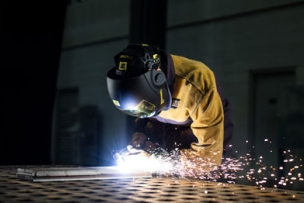The Evolution of Arc Flash Protection
Many arc flash incidents happen because workers are not following the correct procedures when working on energized units.
The National Fire Protection Association (NFPA) has developed an NFPA 70E document titled “Standard for Electrical Safety in the Workplace,” a resource designed to help companies reduce exposure to fire-related risks and occupational injuries and fatalities.
The standard includes guidance on PPE use to reduce or avoid injury from an arc flash accident. It also includes guidance for employers who want to minimize the risk of working with live electrical equipment, such as how to create a safety program, gauging arc flash hazards, and training for workers on arc flash hazards and safe work procedures.
Read more: 5 Tips That Help Improve the Safety of Arc Flash PPE
Companies perform an arc flash analysis of their equipment to determine incident energy levels and the appropriate arc flash PPE categories for working on the equipment. For example, PPE level 2 requires workers to wear, among other protective items, an arc-rated long-sleeved shirt, long pants or arc-rated coveralls, and insulating gloves with protectors.
The construction of arc flash suits has evolved over the past several years thanks to regular safety guideline updates from OSHA and the NFPA. While arc flash suits can’t fully protect you from the harms of an arc flash, they can play a significant part in reducing the harm done by electrical arc flashes.
Of the commonly known fabrics in wide use is Nomex, which was introduced by DuPont in 1967. Inherently flame-resistant, with protection built into the fiber itself, Nomex—and DuPont’s newer Protera fabric, which is a blend of Nomex and Kevlar—offers protection from arc flash incidents. Although the fabrics burn when you hold a flame next to them, they will stop burning as soon as the flame is removed. The woven structure of synthetic fibers in both fabrics makes them poor conductors of heat and electricity, and therefore ideal for insulating against arc flashes.
Protera fabric is newer than Nomex and designed specifically as a lightweight protective fabric for arc flashes, yet it is durable thanks to the inclusion of Kevlar, a high-strength fiber used in bulletproof vests.
Protera’s benefit is that it can be layered with other PPE to ensure comfort when working on category three and four level tasks—the higher danger levels of required arc flash protection—which tend to require heavier grades of PPE, and so may not be ideal for, say, summer work in Southern U.S. states where it tends to be hotter.
While PPE is important, so is good electrical safety training. A well-trained workforce, combined with frequent maintenance and inspection of your equipment for arc flash susceptibility, can greatly reduce the likelihood of an arc flash incident ever happening.
Companies such as Martin Technical offer practical safety training, including classes on electrical safety and arc flash training that are based on NFPA 70E, OSHA and industry best practices.
CLICK HERE to explore product solutions that help maintain a safer workplace while working with electricity.
How does your company manage the danger of arc flash injuries?




Talk to Us!
Leave a reply
Your email address will not be published. Required fields are marked *